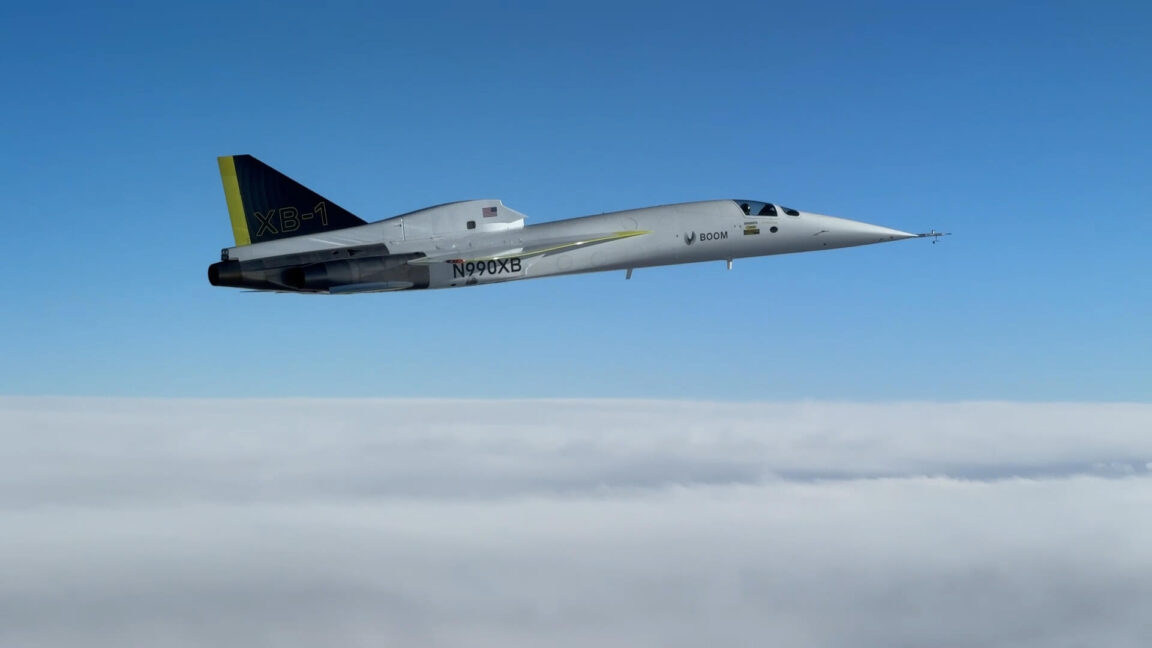
Credit: Boom Supersonic
High above a barren California desert on Tuesday, a privately developed aircraft broke the sound barrier for the first time when Boom Supersonic's XB-1 demonstrator reached Mach 1.122.
Piloted by a former US Navy aviator, Tristan “Geppetto” Brandenburg, the XB-1 vehicle broke the supersonic barrier on three separate occasions before safely landing back at Mojave Air & Space Port, where it had taken off half an hour earlier. It marked a triumphant moment for Boom, which was founded a decade ago to commercialize supersonic air travel.
"A small band of talented and dedicated engineers has accomplished what previously took governments and billions of dollars," said Boom Supersonic's founder and chief executive, Blake Scholl, in a statement.
A stepping stone
This prototype vehicle is a one-third scale technology demonstrator for a commercial aircraft the company is developing, called Overture. Planned specifications for this supersonic airliner include a cruising speed of Mach 1.7 and a maximum speed of Mach 2.2. It is intended to have a maximum range of 4,500 miles (7,200 km) and carry 55 passengers.
Commercial companies are attempting to revive an era of supersonic travel that came and went decades ago. The French and British governments jointly developed the Concorde aircraft in the 1960s, and the Soviet Union developed the Tupolev supersonic aircraft around the same time. Neither was economically successful, and the technology was set aside in the early 2000s.
A new generation of companies, including Boom Supersonic, are aiming to meld new ideas, technology, and a commercial approach to develop more cost-effective travel at supersonic speeds. The significance of Tuesday's flight is that it marks the first time one of these companies has built and flown its own vehicle above the speed of sound.
Now, on to the real thing
Although this is an important and notable step—this flight was the culmination of 11 successful test flights of the XB-1 since March 2024—it is only a step along the path toward development and operation of a commercially successful supersonic aircraft. Now Boom must build the real thing.
The company said the XB-1 demonstrator validates many of the key technologies that will be incorporated into Overture, including carbon-fiber composites, digital stability augmentation, and supersonic intakes. However, Overture will feature a different propulsion system named Symphony. The company is working with several partners, including Florida Turbine Technologies for engine design, GE Additive for additive technology design consulting, and StandardAero for maintenance to develop the engine.
There appears to be plenty of demand in the commercial air travel industry for a company that can develop and deliver supersonic aircraft to the market.
Boom Supersonic said it has taken 130 orders and pre-orders from American Airlines, United Airlines, and Japan Airlines for the Overture aircraft. In 2024, Boom said it completed construction on the Overture "Superfactory" in Greensboro, North Carolina, which will scale to produce 66 Overture aircraft per year. Boom is hoping to start delivering on those orders before the end of the decade.

-
 C114 Communication Network
C114 Communication Network -
 Communication Home
Communication Home


